
10 Facts About Hummingbirds – And other interesting tidbits
Tuesday, July 3, 2018
By: Lisa M. Genier - Adirondack Council Program Analyst
One of my favorite things about spring and summer is seeing the hummingbirds (Trochilidae) zoom around the flowers and my hummingbird feeders.
I’ve always been in awe of these tiny creatures ever since I was a child and we began hanging a hummingbird feeder at our family’s cabin in the Adirondacks. Even today, every summer, we put a feeder up just outside our screened-in porch and watch for the hummingbirds to come and eat.
It’s always exciting when you hear the hummingbirds’ distinct sound as they come closer to the feeder…sort of like a bumblebee who’s had too much coffee. They dart back and forth and up and down - alternating between eating and hovering in place to take a break from their repast. I especially like when they perch on the feeder with their tiny feet while taking a long, seemingly relaxing drink of the sweet sugar and water mixture that they love so much and which provides their sustenance.
Unique Qualities of Hummingbirds
Hummingbirds are interesting creatures and have many unique qualities. Some of these qualities are physical features, others are quirky behaviors. I bet you know a few of these, but others may surprise you.
1. Many Species
I once saw a National Geographic television special on hummingbirds that said that there are over 330 species of hummingbirds! I was shocked. I had no idea, since I was only familiar with one species, as I’m sure you are as well, the Ruby-Throated Hummingbird.
The Male Ruby-Throated Hummingbird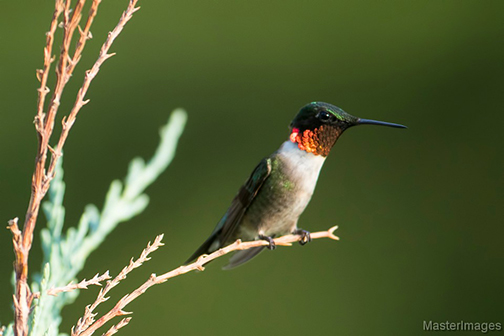
The Female Ruby-Throated Hummingbird 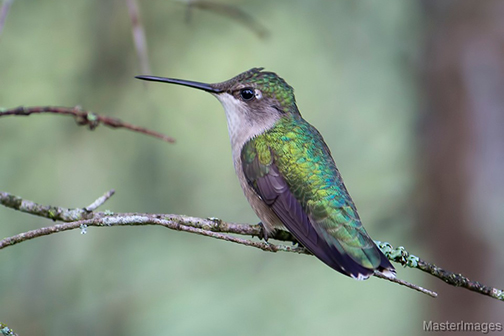
Surprisingly, hummingbirds are only found in the Western Hemisphere, with almost half the species living around the equator. About five percent of hummingbird species live primarily north of Mexico, and only about two dozen species visit the U.S. and Canada. A few species remain year-round in the U.S. along the Pacific coast.
2. They Eat A lot
Hummingbirds have a very high metabolism and must eat all day long just to survive. They consume about half their body weight in bugs and nectar, feeding every 10-15 minutes and visiting 1,000-2,000 flowers throughout the day. In addition to nectar from flowers and feeders, these birds eat small insects, beetles, ants, aphids, gnats, mosquitoes, and wasp. So, hummingbirds are great to have in your backyard!
3. They’re the Smallest
Hummingbirds are the smallest of all bird species. The bee hummingbird of Cuba weighs only 1.95 grams or about as much as a ¼ teaspoon of sugar!
It would be logical that if hummingbirds are the smallest birds, they would also have the tiniest eggs of any bird. For reference, a Ruby-throated hummingbird’s egg is about the size of a pea and its nest is roughly the size of half a walnut shell. And they love to make their homes in gardens because they are secluded and quiet. So please make sure to check branches before you do your spring cleaning in your yard.
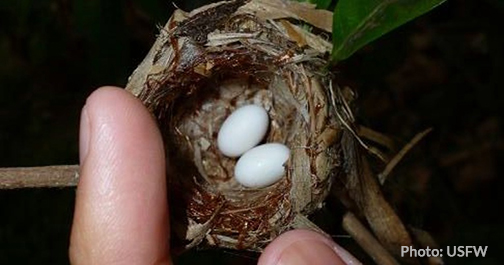
4. Female Builders
Interestingly, only female hummingbirds build nests and will lay only two eggs. The male hummingbird is not involved in raising young, and will often find another mate after the young are hatched. After hatching, baby hummingbirds will stay in the nest for approximately three weeks.
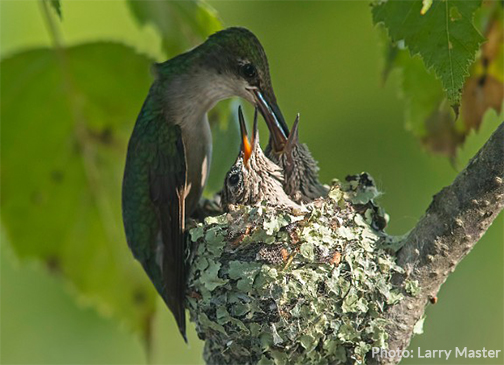
5. They Travel
One thing that surprised me about hummingbirds is that they migrate. In fact, some travel over 2,000 miles twice a year. They winter in Central America or Mexico and migrate north to their breeding grounds in the U.S. during late winter and early spring. Hummingbirds will typically gain 25-40 percent of their body weight before they start migration in order to make their trip. They generally fly alone, often on the same path they’ve flown earlier in their life.
Hummingbirds fly by day when sources of nectar are the most abundant. They also fly low, which allows the birds to see, and stop at, food supplies along the way. Research indicates a hummingbird can travel as much as 23 miles in one day.
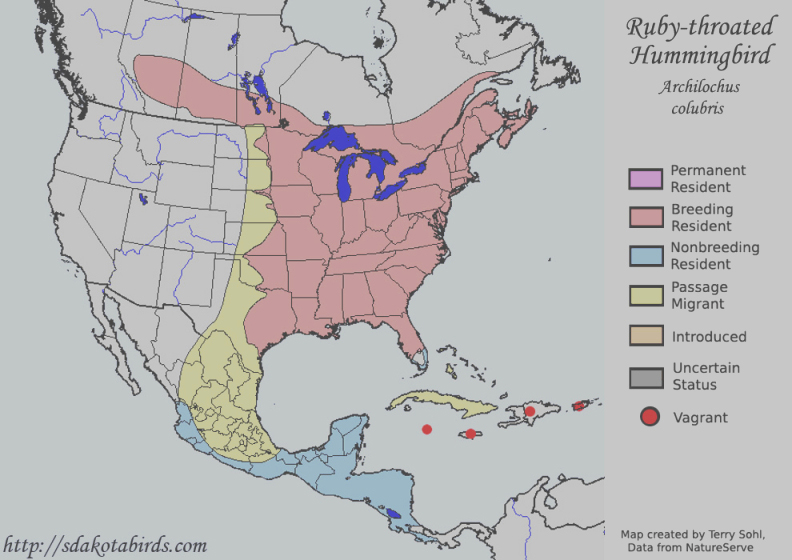
6. They've Got the Moves
No other birds can fly like hummingbirds. They can fly forward, backward, and even upside down! Hummingbirds are also the only vertebrae capable of hovering for a period of time during flight.
7. And They’re Fast
Along with being agile, hummingbirds have speed and stamina. They have been clocked at nearly 30 mph in direct flight and more than 45 mph during courtship dives.
Not only do hummingbirds move from place to place quickly, but their body parts also move rather fast as well. A hummingbird's heart beats from 225 times per minute when it’s at rest and more than 1,200 times per minute when it is flying. Its wings beat about 70 times per second in regular flight and more than 200 times per second while diving.
8. But They Rest Too
Hummingbirds are one of the few groups of birds that go into torpor - a very deep, sleep-like state in which metabolic functions are slowed to a minimum and a very low body temperature is maintained. Hummingbirds have high metabolic demands and their feathers are poor insulators, so going into torpor allows them to survive when conditions make it impossible to maintain their normal 105 degrees Fahrenheit body temperature.
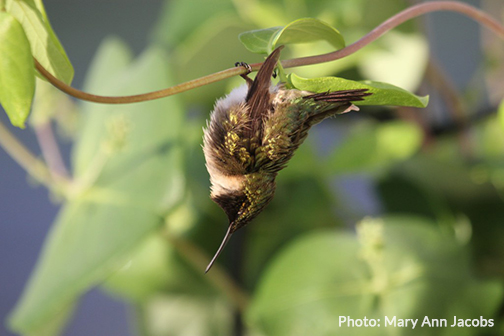 Male Ruby-Throated Hummingbird in Torpor
Male Ruby-Throated Hummingbird in Torpor
Hummingbirds can go into torpor any time of the year when temperature and food conditions demand it. (If torpor lasted for long periods, we would call it hibernation.)
9. They Are Anti-Social (and can be mean!)
Hummingbirds are, for the most part, unsocial creatures. They compete for food sources and often when more than one hummingbird is around, it ends up in a series of high-speed chases. Mating season can get a bit competitive as well, and male hummingbirds get mean. To prove their dominance, male hummingbirds will bob and weave and then use their needle-like beaks like knives and stab each other in the throat. A violent way to get his mate.
10. Big-Brained Bird
A hummingbird’s brain makes up 4.2 percent of its weight; proportionally, that’s the largest of any bird’s. By comparison, our brains are two percent of our body weight. Studies have shown that hummingbirds can remember migration routes and every flower they’ve ever visited. They can also figure out how long to wait between visits so the flowers have time to generate more nectar. They can even recognize humans!
Threats
The average life span of a hummingbird is five years, but they have been known to live for more than 10 years. As with any creature, there are threats to the hummingbirds’ survival…some natural and some man-made.
Climate Change: Unfortunately, hummingbirds are being affected by the earth's changing temperatures due to climate change. Their migratory patterns are changing which is causing different species to be spotted in locations well outside their normal range. This may make it more difficult for them to find food, which may lead to a populations’ decline.
Habitat Loss: Urbanization, agriculture, logging, and development in tropical areas threaten many hummingbird species. Since hummingbirds are so small, even minor development can have a tragic impact on them.
Praying Mantis: Yes, you read it correctly, praying mantis can kill hummingbirds. Even though hummingbirds are about eight times larger than the mantis’ usual meal, they will wait at feeders and launch a sneak attack using their rapid reflexes. So, if you find a praying mantis at your hummingbird feeder, gently remove it and place it at another location. Please don’t kill the praying mantis, they eat bugs and are beneficial to your backyard ecosystems.
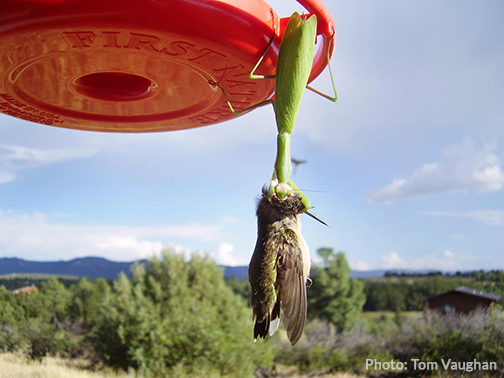
Invasive Plants: People unknowingly choose invasive plants for ornamental value around their lawns. Although these plants are beautiful, they are unfamiliar to hummingbirds and will not provide the nectar they require. Please choose your plants wisely.
Get Yourself a Feeder
If you love hummingbirds as much as I do, get your own feeder, fill it with homemade nectar, and watch the tiny birds come to eat. You will enjoy seeing the hummingbirds, and you will be helping them out with their need to eat a lot! Don’t worry about leaving the feeder up too late in the season, hummingbirds know when to start their migration. They don’t stick around just because there’s nectar. In fact, it’s a good idea to leave your feeder up until the middle to late September to catch any last-minute travelers coming down from the north.
 Lisa M. Genier joined the Council in 1992 working as its Legislative Associate in the Albany office. During her tenure, she played a role in the creation of the Environmental Protection Fund, which has been used to fund land purchases and environmental programs in the Adirondack Park and around the state. She was also a member of the negotiating teams that worked on re-licensing agreements for several hydroelectric facilities in the Park, which preserved thousands of acres of land, expanded recreational opportunities, and protected other natural resources. Lisa now works part-time as Program Analyst writing action alerts, interacting with members, managing the Council’s website, and serving in a consultative role on legislative and other issues
Lisa M. Genier joined the Council in 1992 working as its Legislative Associate in the Albany office. During her tenure, she played a role in the creation of the Environmental Protection Fund, which has been used to fund land purchases and environmental programs in the Adirondack Park and around the state. She was also a member of the negotiating teams that worked on re-licensing agreements for several hydroelectric facilities in the Park, which preserved thousands of acres of land, expanded recreational opportunities, and protected other natural resources. Lisa now works part-time as Program Analyst writing action alerts, interacting with members, managing the Council’s website, and serving in a consultative role on legislative and other issues




